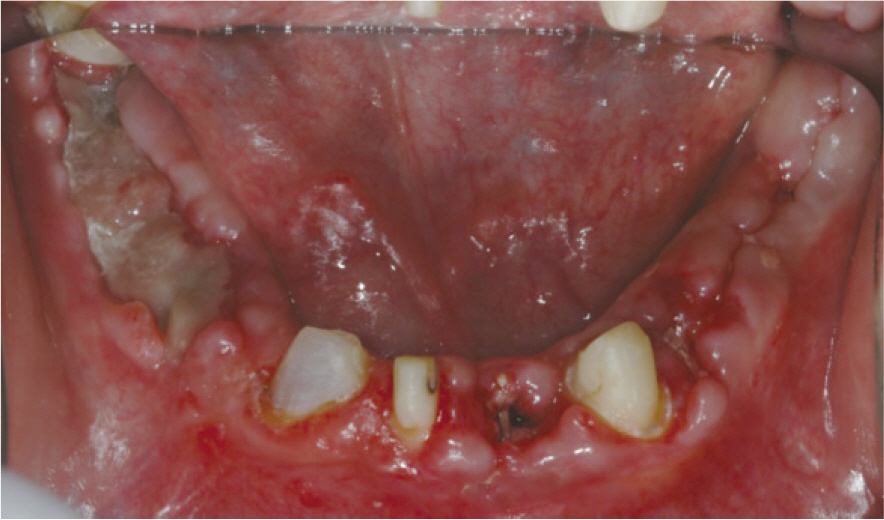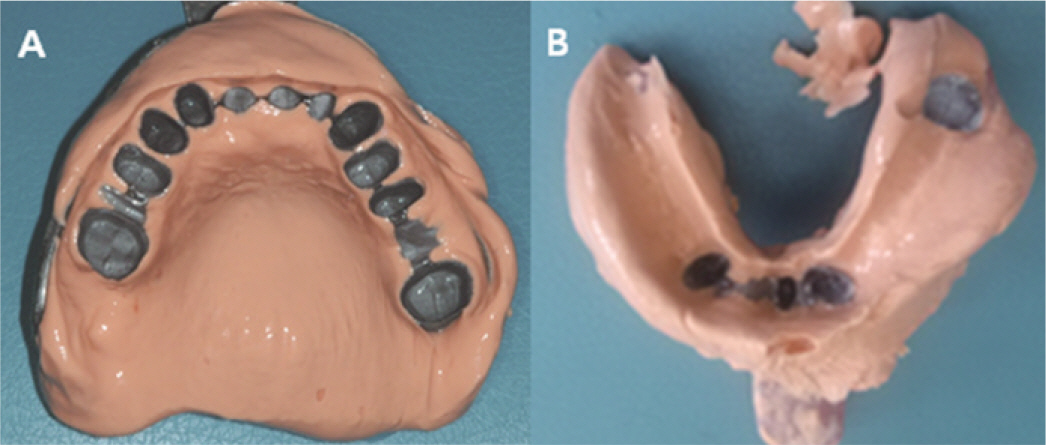J Korean Acad Prosthodont.
2013 Jul;51(3):208-213. 10.4047/jkap.2013.51.3.208.
Full mouth rehabilitation for a disabled patient: a case report
- Affiliations
-
- 1Department of Prosthodontics, School of Dentistry, Chonnam National University, Gwangju, Korea. yhsdent@chonnam.ac.kr
- KMID: 2000170
- DOI: http://doi.org/10.4047/jkap.2013.51.3.208
Abstract
- The spectrum of physically challenged patients who visit to a dental clinic for treatments are diverse: from ones of mild disabilities, who lead their lives in a similar way of ordinary people, to others who suffer from diseases that are difficult to be diagnosed, and need medical expertise due to systemic care or special techniques and instruments because of behavior management and difficulty of treatments. The patient in this case was 25-year-old autistic male patient who visited the clinic on account of overall treatment for multiple carious lesions. He could perform normal daily life to some degree under the care of a guardian. This case report describes predicaments of making a treatment plan resulted from lack of information about disabled patients, and difficulties of proceeding treatment procedures under general anesthesia. It is considered that sufficient consultation and history taking are needed before treatment for disabled patients.
Keyword
Figure
Reference
-
1.Holt RD., Rule DC., Davenport ES., Fung DE. The use of general anaesthesia for tooth extraction in children in London: a multi-centre study. Br Dent J. 1992. 173:333–9.
Article2.Nunn JH. The dental health of mentally and physically handicapped children: a review of the literature. Community Dent Health. 1987. 4:157–68.3.Manley MC., Pahl JM. Dental services for children with mental handicaps: policy changes and parental choices. Br Dent J. 1989. 167:163–7.
Article4.Seo KS., Jang KT., Kim HJ., Yum KW. The status of comprehensive dental treatment and type of disabilities of the patients treated under outpatient general anesthesia at the clinic for the disabled in Seoul national university dental hospital. J Korean Dent Soc Anesth. 2006. 6:82–8.
Article5.Solomon A. Indications for dental anesthesia. Dent Clin North Am. 1987. 31:75–80.6.Smith FK., Deputy BS., Berry FA Jr. Outpatient anesthesia for children undergoing extensive dental treatment. ASDC J Dent Child. 1978. 45:142–5.7.Ghezzi EM., Cha′vez EM., Ship JA. General anesthesia protocol for the dental patient: emphasis for older adults. Spec Care Dentist. 2000. 20:81–92.
Article8.Arvidson K., Bystedt H., Frykholm A., von Konow L., Lothigius E. A 3-year clinical study of Astra dental implants in the treatment of edentulous mandibles. Int J Oral Maxillofac Implants. 1992. 7:321–9.9.Testori T., Wiseman L., Woolfe S., Porter SS. A prospective multicenter clinical study of the Osseotite implant: four-year interim report. Int J Oral Maxillofac Implants. 2001. 16:193–200.10.Gabre P., Martinsson T., Gahnberg L. Longitudinal study of dental caries, tooth mortality and interproximal bone loss in adults with intellectual disability. Eur J Oral Sci. 2001. 109:20–6.
Article11.Smith RA., Berger R., Dodson TB. Risk factors associated with dental implants in healthy and medically compromised patients. Int J Oral Maxillofac Implants. 1992. 7:367–72.12.Rogers JO. Implant-stabilized complete mandibular denture for a patient with cerebral palsy. Dent Update. 1995. 22:23–6.13.American Psychiatric Association. Diagnostic and Statistical Manual of Mental Disorders,. 4th ed.Text Revision. Washington DC: American Psychiatric Association;2000.14.Manley MC., Pahl JM. Dental services for children with mental handicaps: policy changes and parental choices. Br Dent J. 1989. 167:163–7.
Article15.Robertson JR., Ball HC. Dental treatment with general anaesthesia for handicapped patients. Br Dent J. 1973. 134:151–3.
Article16.Limeres Posse J., Va′zquez Garcl′a E., Medina Henrl′quez J., Toma′s Carmona I., Ferna′ndez Feijoo J., Diz Dios P. Pre-assessment of severely handicapped patients suitable of dental treatment under general anesthesia. Med Oral. 2003. 8:353–60.17.Moon SY., Kim SG. Dental treatment of psychiatric patients. Korean Assoc Disabil Oral Health. 2006. 2:1–9.18.Fahy A., Marshall M. Postanaesthetic morbidity in out-patients. Br J Anaesth. 1969. 41:433–8.
Article19.Kay KS. Removable partial prosthodontics. 4th ed.Narae publishing Inc;Seoul, Korea: 2007. p. 644.
- Full Text Links
- Actions
-
Cited
- CITED
-
- Close
- Share
- Similar articles
-
- Prosthetic Rehabilitation in Patients with Severe Hearing Disability and Loss of Occlusal Vertical Dimension: A Case Report
- Ten-year follow-up of full mouth rehabilitation with fixed prostheses using implants and natural tooth
- Full-mouth rehabilitation in a patient with severe erosion and wear using various digital tools: a case report
- Full mounth rehabilitation using OP finder ® system for patient with inadequate occlusal plane and multiple occlusal wear tooth state: a case report
- Mandibular full arch rehabilitation of a patient with severely worn dentition after completion of maxillary full arch rehabilitation









